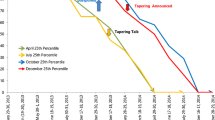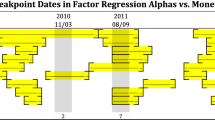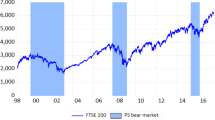Abstract
This paper investigates the sensitivity of various financial markets to surprises in the federal funds rate. We employ the methodology outlined by Kuttner [2001] to reevaluate prior results and expand the analysis to include data up until the financial crisis, inclusive. Our data set includes additional events to previous studies, which led our results to differ than those earlier studies. For our sample excluding the financial crisis (1994–2007), we found that Fed funds surprises had a significant effect on the percent change in the S&P 500 index, but generally had little significant effect on Treasury yields and the trade-weighted dollar. We also studied a decomposition of the yield curve and found that the lack of significant effect on Treasury yields was a result of the offsetting effects of surprises on the term premium and risk-neutral yield. In addition, our analysis of the financial crisis revealed several shifts in the response of many asset classes, likely a result of the large signaling effects contained in monetary policy combined with the extraordinary events that were occurring.







Similar content being viewed by others
Notes
We used announcement dates provided in Fleming and Piazzesi [2005] from 1994 to 2004. From 2004 onward, the meeting dates were obtained from Bloomberg, LP.
The risk-neutral rate is the interest rate equal to the expected return from continuously rolling over short-maturity Treasury Bills. Hence, the risk-neutral rate is the expected average short-term interest rate over the life of a longer-term bond. The term premium, on the other hand, is the residual. We assume that Treasuries carry no default risk, as is common in both theory and practice. This residual is, therefore, the compensation investors receive for the risk associated with short-term rates behaving differently in the future than expected [Kim and Wright 2005].
We also repeated our analysis of the sensitivity of the term premium to the absolute value of the surprise to see if the magnitude of the surprise was the driver of changes in the term premium, rather than the actual surprise. The model fit was better when using the actual surprise, however.
There are many different ways of discounting expected future cash flows from an equity security and a detailed explanation is beyond the purview of this study. That said, the discount rate can be thought of as the risk-free rate plus a risk premium, to account for the fact that cash flow from equities are uncertain.
Kuttner [2001] restricts the analysis to days when the target funds rate was changed. We, however, include all FOMC meetings with a nonzero surprise. This is because no action by the Federal Reserve when the market is expecting action is also a surprise, in our opinion, and markets should react. That said, this may come at the cost of adding noise to our analysis.
We use the 30-day Fed funds futures offered by the CME Group. Our analysis is restricted to the time period 1994–2014. The futures are quoted as 100 minus the average daily effective Fed funds rate. The last trading day for the active contract is the last business day of the month. Contracts are cash settled on the first business day following the last trading day. We used the generic first future data series from Bloomberg.
We used the daily difference in yields for the Treasury market, the daily percent change in the S&P 500 index for equities and the daily percent change in dollar indices for foreign exchange.
We also ran analysis including an interaction term for positive surprises to test for asymmetric responses to Fed funds surprises. In general, short-term Treasury yields and risk-neutral yields are more sensitive to positive surprises, while the term premium is more sensitive to negative surprises. In addition, only nonzero surprises were included.
References
Adrian, Tobias, Richard K. Crump and Emanuel Moench . 2013. “Pricing the Term Structure with Linear Regressions.” Journal of Financial Economics, 110 (1): 110–138.
Barro, Robert . 1981. Money, Expectations and Business Cycles. Academic Press.
Bernanke, Ben S. and Kenneth N. Kuttner . 2005. “What Explains the Stock Market’s Reaction to Federal Reserve Policy?” Journal of Finance, 60 (3): 1221–1257.
Crump, Richard, Emanuel Moench, William O’Boyle, Matthew Raskin, Carlo Rosa and Lisa Stowe . 2014. Survey Measures of Expectations for the Policy Rate. Liberty Street Economics, Federal Reserve Bank of New York.
Evans, Charles L. 1994. The Dollar and the Federal Funds Rate. Chicago Fed Letter.
Fama, Eugene F. 1969. “Efficient Capital Markets: A Review of Theory and Empirical Work.” The Journal of Finance, 25 (2): 383–417.
Fleming, Michael J. and Monika Piazzesi . 2005. Monetary Policy Tick-by-Tick. Federal Reserve Bank of New York Working Paper.
Gurkaynak, Refet S., Brian P. Sack and Eric T. Swanson . 2007. “Market-Based Measures of Monetary Policy Expectations.” Journal of Business and Economic Statistics, 25 (2): 201–212.
Kim, Suk-Joong, Michael D. McKenzie and Robert W. Faff . 2004. “Macroeconomic News Announcements and the Role of Expectations: Evidence for US Bond, Stock and Foreign Exchange Markets.” Journal of Multinational Financial Management, 14 (4): 217–232.
Kim, Don H. and Jonathan H. Wright . 2005. An Arbitrage-Free Three-Factor Term Structure Model and the Recent Behavior of Long-Term Yields and Distant-Horizon Forward Rates. Federal Reserve Board Finance and Economics Discussion Series.
Kuttner, Kenneth N. 2001. “Monetary Policy Surprises and Interest Rates: Evidence from the Fed Funds Futures Market.” Journal of Monetary Economics, 47 (3): 523–444.
Silvia, John E. 2014. Corporate Profits and Its Link in the Macro Economy. Wells Fargo Economics Group.
Additional information
*John Silvia is a managing director and the chief economist for Wells Fargo. He has held this position since he joined Wachovia, a Wells Fargo predecessor, in 2002 as the company’s chief economist. Prior to his current position, he worked in Capitol Hill as senior economist for the U.S. Senate Joint Economic Committee and chief economist for the U.S. Senate Banking, Housing and Urban Affairs Committee. Before that, he was chief economist of Kemper Funds and managing director of Scudder Kemper Investments, Inc. Silvia served as the president of NABE in 2015 and was awarded a NABE Fellow Certificate of Recognition in 2011 for Outstanding Contributions to the Business Economics Profession and Leadership among Business Economists to the Nation. He holds B.A. and Ph.D. degrees in economics from Northeastern University in Boston and has a master’s degree in economics from Brown University. John is a Certified Business Economist (CBE). Azhar Iqbal is a director and econometrician at Wells Fargo, responsible for providing quantitative analysis to the Economics group and modeling and forecasting of macro and financial variables. Before joining Wells Fargo in 2007, he was an economist and course instructor at the Applied Economics Research Center at the University of Karachi in Pakistan. He has also worked as an economist at the United Nations, Arif-Habib Investment Bank, and for Government of Pakistan-funded projects. He received his bachelor’s degree in economics from the University of Punjab and has a master’s degree in economic forecasting from the University at Albany, State University of New York, where he also earned a Certificate of Graduate Study in economic forecasting. He also has master’s degrees in applied science and applied economics from University of Karachi, and a master’s degree in econometrics and mathematics from the University of the Punjab in Lahore, Pakistan. Alex Moehring is an economic analyst with Wells Fargo Securities. He is responsible for covering U.S. macro and regional economic trends. He joined the economics group in 2014. He contributes to the group’s Weekly Economic & Financial Commentary and regional reports. Moehring graduated from the University of North Carolina at Chapel Hill, earning a B.S. in business administration with an investments concentration, a B.A. in economics and a minor in mathematics.
Rights and permissions
About this article
Cite this article
Silvia, J., Iqbal, A. & Moehring, A. Fed Funds Rate Surprises and Financial Markets. Bus Econ 51, 36–49 (2016). https://doi.org/10.1057/be.2016.10
Published:
Issue Date:
DOI: https://doi.org/10.1057/be.2016.10




